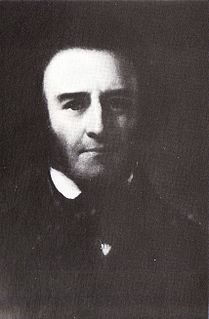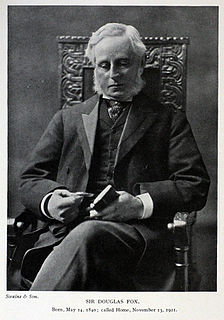Related Research Articles

Sir Thomas Bouch was a British railway engineer. He was born in Thursby, near Carlisle, Cumberland, and lived in Edinburgh. As manager of the Edinburgh and Northern Railway he introduced the first roll-on/roll-off train ferry service in the world. Subsequently as a consulting engineer, he helped develop the caisson and popularised the use of lattice girders in railway bridges. He was knighted after the successful completion of the first Tay Railway Bridge, but his reputation was destroyed by the subsequent Tay Bridge Disaster, in which 75 people are believed to have died as a result of defects in design, construction and maintenance, for all of which Bouch was held responsible. He died within 18 months of being knighted.

The Blackwater Reservoir is a reservoir created behind a dam in the mountains above Kinlochleven, Lochaber, Highland, Scotland. At over 914 m long, the dam is the longest in the Highlands.
Patrick Walter Meik was an English civil engineer and part of a minor engineering dynasty. His father Thomas Meik was also an engineer, as was his younger brother Charles Meik.
Thomas Meik was a 19th-century Scottish engineer.
Sir George Cunningham Buchanan was a British civil engineer particularly associated with harbour works in Burma, Iraq and Bombay, during the early years of the 20th century.
Sir William Halcrow was one of the most notable English civil engineers of the 20th century, particularly renowned for his expertise in the design of tunnels and for projects during the Second World War.

James Walker was an influential Scottish civil engineer.
Sir Alexander Gibb & Partners was a British firm of consulting civil engineers, based at Queen Anne's Lodge, Queen Anne's Gate and subsequently Telford House, Tothill Street, Westminster, London, until 1974, when it relocated to Earley House, 427 London Road, Reading, Berkshire.
Brigadier-General Sir Alexander Gibb was a Scottish civil engineer. After serving as Civil Engineer-in-Chief to the Admiralty and Director-General of Civil Engineering at the Ministry of Transport, he established the engineering consultancy firm Sir Alexander Gibb & Partners.

James Meadows Rendel FRS was a British civil engineer.

Scott Wilson Group plc was a global integrated design and engineering consultancy with its headquarters in the United Kingdom. Founded as a civil engineering firm in 1951, the company broadened its range of services through acquisitions. Scott Wilson offered consultancy and professional services in the railways, buildings and infrastructure, environment and natural resources and roads sectors, and at its peak employed 5,500 people in 80 offices worldwide. Scott Wilson became a public limited company in 2006, and in 2010 was purchased by URS Corporation that in turn was purchased by AECOM.
The Rhondda and Swansea Bay Railway was a Welsh railway company formed to connect the upper end of the Rhondda Fawr with Swansea, with the chief objective of transporting coal and other minerals to Swansea docks. It was incorporated in 1882, but at first the connection to Swansea from Briton Ferry was refused.

James Abernethy FRSE was a Scottish civil engineer.
Halcrow Group Limited was a multinational engineering consultancy company, based in the United Kingdom
Holloway Brothers (London) Ltd was a leading English construction company specialising in building and heavy civil engineering work based in London.
The Edinburgh and Northern Railway was a railway company authorised in 1845 to connect Edinburgh to both Perth and Dundee. It relied on ferry crossings of the Firth of Forth and the Firth of Tay, but despite those disadvantages it proved extremely successful. It took over a short railway on the southern shore of the Forth giving a direct connection to Edinburgh, and it changed its name to the Edinburgh, Perth and Dundee Railway.

Sir (Charles) Douglas Fox was an English civil engineer.
The Lochaber hydroelectric scheme is a hydroelectric power generation project constructed in the Lochaber area of the western Scottish Highlands after the First World War. Like its predecessor at Kinlochleven, it was intended to provide electricity for aluminium production, this time at Fort William, a little further north. It is still in operation.
The Fife Coast Railway was a railway line running round the southern and eastern part of the county of Fife, in Scotland. It was built in stages by four railway companies:

Edward Orpen Moriarty (1824-1896) MA MInstCE was an Australian civil engineer, who undertook a number of important public works in New South Wales in the late nineteenth century.
References
- 1 2 3 4 "Charles Scott Meik (Obituary 1923)". Grace's Guide. Retrieved 7 October 2015.
- ↑ Charles Scott Meik: 1853 - 1923, Gazetteer for Scotland. Retrieved: 8 October 2015